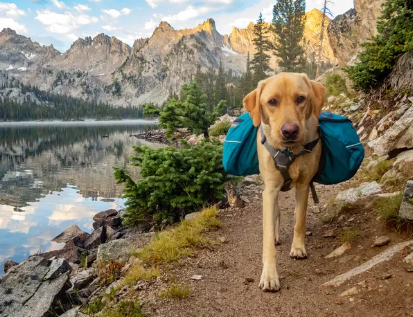When vacationing in nature, it is the right choice to consider bringing your pet to enjoy the outdoors together. Before planning a visit to a national park, make sure to thoroughly research the pet policies of the park or parks you plan to visit so as not to be caught off guard.
What Are Pet-Friendly National Parks?
The United States has 63 national parks. A truly pet-friendly park is one that allows pets to enter most areas of the park that people are allowed to enter, such as trails and observation decks; But this is not always the case. While most national parks allow pets to some extent, some strictly restrict pets from entering certain areas, such as parking lots, campgrounds, or roads. This is usually for the safety of pets and other wildlife in the park.

Rules and Regulations for Pet-Friendly National Parks
In pet-friendly national parks, the National Park Service (NPS) has developed a set of guidelines called “BARK”:
- Bag your pet’s waste
- Keep your pet on a leash at all times
- Respect for wildlife
- Know where you can go
Some even offer park ranger-led programs through which your dog can become a “barking ranger.”
In addition to the basic principles, the NPS has a more thorough set of rules that apply to all parks. Among other things, pets are not allowed indoors (except for service animals), unreasonable noise (e.g., excessive howling or barking, disturbing other visitors or wildlife) is prohibited in the premises, and owners cannot tie up pets unattended.
In addition to the regulations nationwide, many parks have specific rules and regulations, especially those related to places where pets are allowed. The strictest parks may only restrict pets to developed areas such as parking lots (including pets that are picked up or kept in cages), but even the most pet-friendly parks may have some restrictions, such as prohibiting pets from particularly challenging trails, such as the Old Rag hike in Shenandoah National Park.
NPS has an interactive map where users can click through pet policies in different national parks, as well as hundreds of national monuments, battlefields, nature preserves, and other historic areas.
Types of Pet-Friendly National Parks
Based on these rules, here are some of the most pet-friendly national parks:
- Cuyahoga Valley National Park: More than 100 miles of hiking trails in this Ohio park allow dogs, cats, and other domestic pets. Just avoid the mountain bike trails.
- Acadia National Park: This Maine seaside attraction allows 100 miles of hiking trails and 45 miles of road with pets. Pets are also allowed at most campsites. Here, both pets and humans are forbidden to swim in lakes that are part of the public water supply.
- Grand Canyon National Park: While pets are not allowed below the edge of the canyon interior trails, pets are allowed on the trails above the rim, as well as at certain campgrounds. There is a Grand Canyon kennel on site where visitors can board their dogs and cats while doing some more adventurous hikes.
- Petrified Forest National Park: This Arizona park allows pets on all trails and backcountry.

Tips for Visiting Pet-Friendly National Parks
Traveling with your pet can enrich the lives of both pets and owners and provide opportunities to bond, but preparation is key to a successful visit to the national park.
Decide if It’s Worth It
Many parks have strict restrictions on pets, so be sure to consider whether it’s worth bringing your pet along. If you choose to bring them, there may be restrictions on the activities you can attend and where you can stay.
Know the Rules
Knowing the specific rules of the park you plan to visit is essential for having fun and respecting the national park. Breaking the rules could end up causing harm to wildlife, other visitors, and even your pet.
Be Prepared
In addition to traveling with basic items such as food, water, snacks, and toys, it is also important to be prepared for different situations on your trip. You should travel with a pet first aid kit and make sure your pet is taking proper flea, tick, and heartworm medications to prepare for long outdoor activities. Also, think about what you would do if you wanted to do a hike or activity that doesn’t allow pets. Do you have a backup plan for your pet?
Be Responsible
You will be responsible for your pet’s actions, so be sure to keep them under control. Practice basic commands and etiquette in public before traveling, and once your pet is back in its usual place, things will be very different.